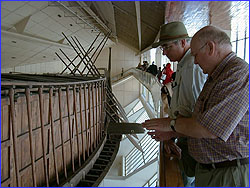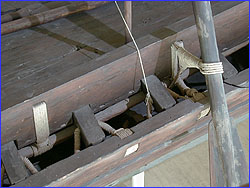
|
 |
 |
by Peter Tyson March 6, 1999 The Egyptian excavator Hag Ahmed Youssef Moustafa died two weeks ago at age 86. His death marked one end of a story that began 4,600 years ago here on the Giza Plateau, a story that bears in its way on how the ancient Egyptians achieved such monumental engineering feats as quarrying, moving, and raising obelisks. Our NOVA team, which coalesced in Giza last night, was immersed in that story today as we examined and filmed the famous Solar Barque of Khufu. The world's oldest boat of such size and sophistication, the barque was first built in the 26th century B.C. It was built a second time in the 20th century A.D., when workmen reconstructed it under the guidance of Hag Ahmed. The modern tale of the Solar Barque begins in 1954. That year, the Egyptologist Kamal el Mallakh, acting on a hunch, got permission to look beneath a wall that paralleled the Great Pyramid on its southern flank. Mallakh thought he might find a boat pit there to match the ones already known from the pyramid's east side. We saw one of them today: It was a long, narrow hole in the ground, chiseled out of the solid rock of the plateau in the shape of a boat. Scholars believe the ancients may have built these recessed "boats" to transport the pharaoh in the afterlife. Digging beneath the wall, Mallakh came upon a row of enormous limestone blocks. Long fascinated by boat pits, Mallakh's heart must have raced at the discovery. On one of the blocks, he made out the cartouche of Djedefre, Khufu's son and successor. Then his heart must have beat even faster. It took a painfully long time to convince the authorities to let him excavate, but finally permission was granted. Breaking a small hole between the blocks, Mallakh was immediately hit by the odor of wood. This afternoon, as our team stood in the blinding sun by one of the Khufu boat pits, Dr. Zahi Hawass, Director of the Pyramids, remembered chatting with Mallakh about six months before he died. "He told me that when he opened that hole, he could smell history." In a scene that must have recalled the day in 1922 when Howard Carter first opened the tomb of Tutankhamen, Mallakh used a mirror to shine a shaft of sunlight down into the hole. His eyes fell on a wooden oar. He had found the Solar Barque of Khufu.
In the years after Mallakh's astonishing discovery, workers carefully removed, restored, and reconstructed the vessel. Today it is housed in a boat-shaped museum built over the pit where it was found. "My jaw dropped when I first saw it," Owain Roberts recalled today as he stood near the boat's stern. The same can be said of my own, and it has stayed dropped since I first visited the museum in January to help shoot a composite portrait of the boat. There's something about the fact that it's made of wood—wood that came from trees that were alive during Khufu's reign - that carries you back to that half-mythical age even more effectively than the Pyramids or Sphinx can. It's as if, in standing before it, you are one step away from the pharaohs themselves. As if the faint aroma arising from the cedarwood planking is matched by a faint echo of workmen's adzes shaping the vessel's timbers, of the whispered voices of high priests directing the pharaoh's pallbearers on its smooth-planked deck. The boat has presence. Like the Lincoln Memorial, it is at once massive and graceful, daunting and delicate. It is also a marvel of engineering. "They knew all the tricks," our Welsh-born boatbuilder Roberts told me this afternoon, shaking his head in silent appreciation. Those tricks included lashing planks so tightly together with ropes of halfa grass that they remained watertight without caulking, and locking timbers together with wooden battens so they wouldn't move relative to one another. The 144-foot-long craft has some planks a full 76 feet long, which the Egyptian builders had to bend to match the curve of the hull, and scholars estimate its total dead weight at 150 tons. Despite its solidity, the Solar Barque could not have carried an obelisk. That's not why we paid it a visit. We did so because, as Mark Lehner noted, "it represents an outstanding example of the thinking about complex construction in that period." It set the stage for later obelisk barges, like the one pictured in relief that we'll visit at Hatshepsut's temple in Luxor, not to mention other feats of engineering skill. The Solar Barque, in short, is one crumb on the trail of the obelisk-makers. Tomorrow we head to the Egyptian Museum in Cairo to search for other examples of supreme workmanship. Peter Tyson is Online Producer of NOVA. Obelisk Raised! (September 12) In the Groove (September 1) The Third Attempt (August 27) Angle of Repose (March 25) A Tale of Two Obelisks (March 24) Rising Toward the Sun (March 23) Into Position (March 22) On an Anthill in Aswan (March 21) Ready to Go (March 20) Gifts of the River (March 19) By Camel to a Lost Obelisk (March 18) The Unfinished Obelisk (March 16) Pulling Together (March 14) Balloon Flight Over Ancient Thebes (March 12) The Queen Who Would Be King (March 10) Rock of Ages (March 8) The Solar Barque (March 6) Coughing Up an Obelisk (March 4) Explore Ancient Egypt | Raising the Obelisk | Meet the Team Dispatches | Pyramids | E-Mail | Resources Classroom Resources | Site Map | Mysteries of the Nile Home Editor's Picks | Previous Sites | Join Us/E-mail | TV/Web Schedule About NOVA | Teachers | Site Map | Shop | Jobs | Search | To print PBS Online | NOVA Online | WGBH © | Updated November 2000 |
 Mark Lehner (l) and Owain Roberts (r) examine the
Solar Barque of Khufu.
Mark Lehner (l) and Owain Roberts (r) examine the
Solar Barque of Khufu.
 The Solar Barque's rigging
The Solar Barque's rigging